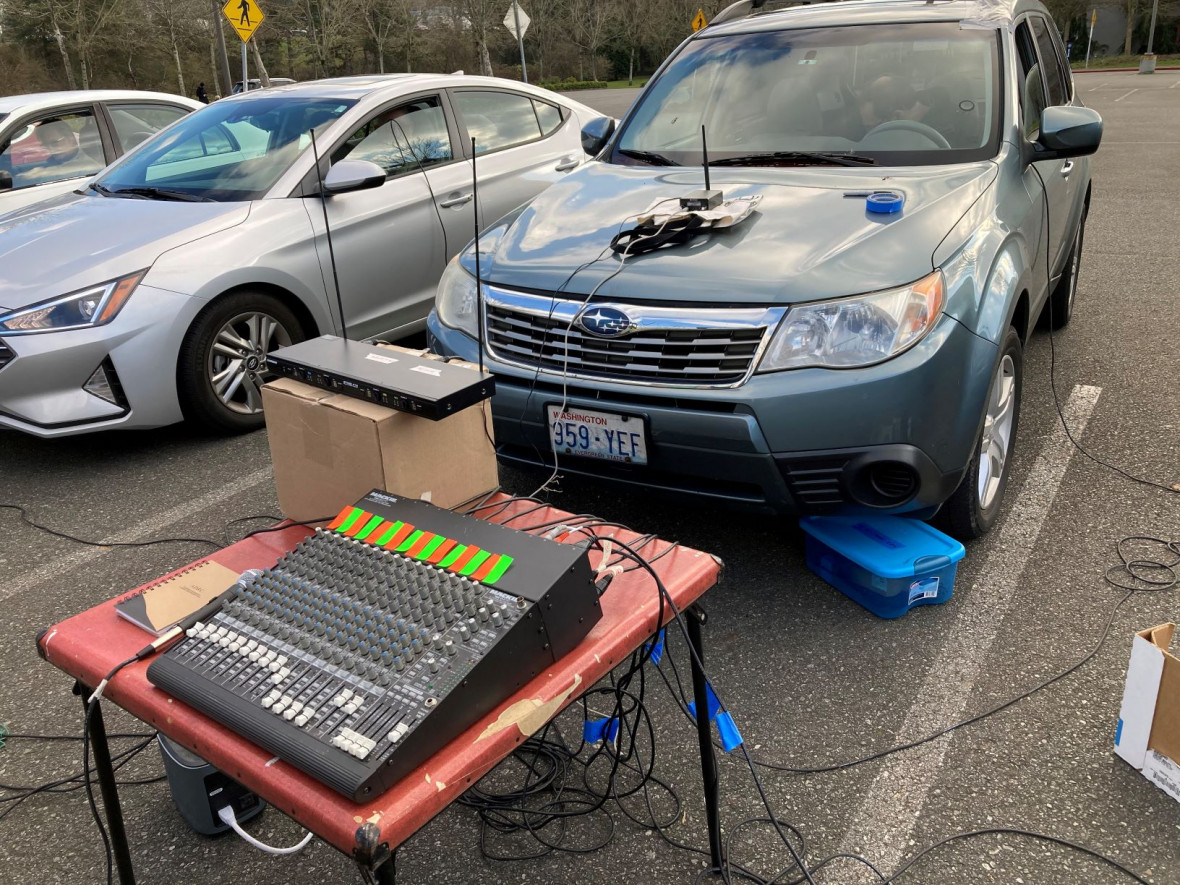
Car Chords notes (Covid safe singing/rehearsal)
Covid-19 safe in-car/outdoor singing overview
The idea here is having Covid safe rehearsals for singers. This is done by having everyone isolated in their own car. Everyone has a microphone and listens to a mix of everyone together over either their car's FM radio, or a portable MP3 player with an FM radio. Chorus members had previously tried multiple times to use "real time" internet based software such as Jamulus. The inherent latency of both the internet and typical laptop audio (30 to 80 milliseconds), coupled with the difficulty of configuring said laptops in the first place, eliminated that as a viable option for the chorus. The latency is a big problem for a capella singing in particular. Both of these issues are addressed with the set up outlined next.
How does this work? The journey from voice to ear is as follows:
- Singers gather in their cars in a parking lot somewhere.
- Each singer has their own microphone, either wired or wireless
- All microphones signals are mixed together
- The mixed signal is transmitted over an FM transmitter
- Each singer listens to the mixed signal over an FM radio
Here is a little more detail on our specific experiences at each of those steps.
Gathering
So far we have done some testing with quartets up to a small VLQ in a public park parking lot. The largest group so far has been only 9 cars. We hope to get up to 20-25 cars. We met in the parking lot at North Seattle College on a few weekends. It has been basically empty and nobody has bothered us. We did not ask for permission tbh. We have scouted a Sound Transit parking garage at Northgate. It is also essentially empty until the light rail station opens there. In that case, however, a security guard told us we could not use it without permission. They have a process for requesting use of facilities but it has a $500 application fee(!) which we have asked to be waived. The beauty of such a garage would be cover from the rain and ability to schedule a session regardless of the forecast. We are reluctant to set up the equipment in the rain. With the 9 cars noted, we were able to stay within marked parking slots. With a larger number, we will surely need to color outside the lines in order to accomdate both cables or wireless limits, as well as having everyone able to see a director.
Microphones
Wireless
Wireless microphones are a mixed bag. They avoid the need to run a lot of microphone cable, but are subject to radio interference and distance limits. The radio interference is because all wireless systems are "unlicensed" (i.e., a radio license is not required) and share radio frequencies with other devices. All of the units we have tried so far have a way to select multiple frequencies, but the "clear" frequencies seem to be location dependent, at a minimum, and some fiddling around is necessary to configure them.
At the moment we have tried two different wireless systems. Both of them have a single receiver which supports four separate microphones. They both have a combined output from their four mics, or a separate output from each mic.
The Phenyx Pro 7000b uses UHF frequencies, and automatically selects a frequency without interference. It uses a headset style mic. Saul has just acquired this and says the quality is fine, and a different mic can be used if desired. Not clear how many units can be used simultaneously, but it should be at least a few. About $75 per mic.
The Samson Stage 412 uses VHF frequencies. There are less available frequencies in this band. As with the Phenyx, each of the four mics chooses a frequency within a specific range. For this unit the claim is up to three sets (total 12 mics) can be used together. However, I have observed that one of the groups shares the band with local TV station channel 9. Its mics are handheld, around $70/mic for the system.
We have limited experience so far using more than one set of wireless mics together. In earlier tests the useful range varied, with some indication that using one from inside a car limits the range further.
Wired
Wired microphones are good in that they are not vulnerable to radio interference. They need both a cable to the mixer, and a mixer input that supports a mic input (more on that next). We have used microphones with "balanced" output, which uses cables with XLR connectors. The good news is that fairly long cables can be used without problems, though I don't think we've gone over 50 feet yet. Multiple cables can be connected together to go further.
Most of our wired mics are Shure SM58, a few Shure SM57, and an odd Audio-Technica something or other. They are around $100 new, though we managed to get a half dozen (very) used ones for about $25 each, which still sound great. The XLR cables are something like $20 for 25 footers, more like $35 for 50 footers, though prices can vary quite a bit.
At our last session (here), 10 of our 11 singers used wired mics.
Audio mixer
The mixer is where all of the mics are combined into a single signal, either mono or stereo. Each wired microphone needs to be connected to an input with a mic preamp. As noted, the wireless sets of four we are using can provide a combined output, needing only one input on the mixer. The cost of the mixer seems to be more or less proportional to the number of inputs. A further consideration is that for many mixers, not all of the inputs will be for mics. For example, I have a Peavey PV6, but it only supports 4 microphone inputs. It can mix 6 inputs, but only as two pairs of stereo line level inputs. In our earlier tests, we used a couple of small mixers, including the Peavey, with the combined output going into another mixer's input. With one of the inputs being a set of 4 wireless mics, we still only got up to about 8 mics, and it was tricky to get levels set reasonably, and kind of a mess even with such a small number of inputs, with mixer connected to mixer. Similar mixers with 4-6 input channels are in the $200 price range new.
We recently acquired a used Mackie 1604 VLZ which has 16 inputs, all of which can be microphones. The link is to a similar one on eBay. A new version of basically the same mixer sells for $1000 new. It was nice to be able to preset gain levels for all of our wired microphones ahead of time, as they vary somewhat depending on the mic. When we actually started singing it was nice to be able to adjust each singer individually to compensate for how they sang, and how they held their mic. Using the two wireless sets as single inputs each gives us 8 mics on two mixer inputs, plus 14 wired mics, for a total of 22. We will likely add more wireless sets of 4 and drop a wired mic to scale up if needed.
With something like the Mackie, it's inputs can be grouped into 4 separately controllable outputs. This would allow separate level control for each part, say. And panning them in the stereo field so hear them more distinctly. But it would mean assigning all four mics from a single wireless set to a single part, if we use the combined output to support the most microphone.
Jim was concerned about quality issues buying used equipment, and he was somewhat right in this case. The left channel output on the Mackie drops out if the signal is not strong after a few minutes. A strong level makes it kick back in again (the "somewhat right" part). As long as we were actively singing, this did not seem to occur. Nonetheless, the mixer is at a repair shop where hopefully they can reproduce and fix the problem.
FM transmitter
This is where we are still learning something new every day, and having a bit of trouble. This is another "unlicensed" (i.e., do not need a license) device, which is nonetheless subject to regulations to strictly limit its ability to interfere with other devices. It is covered by FCC regulation Part 15, which limits the range it is allowed to transmit over. That limit is on the order of a couple hundred feet, at the most. A device that conforms is not even supposed to be modified, say, by using a better antenna to increase that range.
We are using a Retekess TR508 which has a legal "low power" mode (100 milliwatts), and a, presumably illegal "high power" (500 milliwatts) mode. The get out of jail card seems to be to advertise usage for church services, presuming nobody will bust them. Our recent gathering used it in legal mode, and one of our members was having trouble receiving its signal when less than a handful of cars away. He moved to a closer slot and had no further trouble.
The other trouble we had was intermittment loud hum or buzzing. It often started when adding a new input cable to the mixer, sometimes just touching a cable, and in Jim's case, just looking at it sideways. Through trial and error we discovered that simply unplugging its power supply, waiting 5 seconds, and plugging it in again would bring it back without the interference. Once everyone was set up and we stopped touching things, we went most of the time without further problems. We have a number of ideas on things to try and eliminate the problem completely.
FM radio
We were concerned about potential feedback using a car radio, but that was mostly a non-issue except when someone (Randy?) held their mic right near their car speaker briefly. Otherwise, when held in front of the singer, the directional pickup of the mics we used don't pick up much sound other than the singer.
I actually ended up singing outside of my car to fiddle with the mixer, and Tyler walked over, so both of us used a portable FM radio and earbuds. That worked fine also. Search for "mp3 player with FM" and there seem to be a number for about $25. Bonus is they will allow you to record off the radio.
Lastly, we just learned that the US and EU use different "preemphasis" standards for FM radio. Preemphsis boosts higher frequencies before transmitting, and the radio attenuates them, effectively reducing the hiss noise from the signal. The Retekess unit we have uses the EU standard, 50 (microseconds, don't ask) which starts boosting audio above 3183 hz. The US standard, 75 microseconds, starts boosting audio above 2122 hz. Because we have US radios, it seems like you have turned the treble down. Note that the note A above middle C is 440 hz, which only tenors and brave leads aspire to normally, so we're only talking overtones. But those overtones are why we sing barbershop, after all! We should be able to compensate by adjusting the EQ on the mixer to boost those frequencies. Something to try next time.
Last bits
Some sort of power is needed to power the audio mixer, wireless receiver, and FM transmitter. Some units might have the ability to be powered from 12 volts DC, but one or most will need AC. Jim has a personal unit, the River EF1 Pro, which has the capacity to run our modest load for many hours. It's also a bit pricey, on the order of $500. A quick search did not find others with similar capability much cheaper.
Saul's quartet has been rehearsing outside using a PA system instead of FM radio. This has both the advantage and disadvantage of attracting a crowd. Distance also causes latency, roughly a millisecond per foot, and we earlier found that when everyone heard others 50 milliseconds late, every up tune turned into a very slow ballad. And of course, the big "safe singing" idea is that everyone is singing in their own air, in their car with the windows rolled up.



